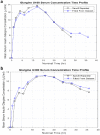In Silico Examination of Initiation of Long-Acting Insulin Analogs Toujeo Compared to Lantus Under 3 Dosing Titration Rules in Virtual Type 2 Diabetes Subjects
- PMID: 31288531
- PMCID: PMC7753861
- DOI: 10.1177/1932296819861586
In Silico Examination of Initiation of Long-Acting Insulin Analogs Toujeo Compared to Lantus Under 3 Dosing Titration Rules in Virtual Type 2 Diabetes Subjects
Abstract
Background: Despite the benefits and clinical necessity of insulin treatment in type 2 diabetes (T2D), healthcare providers are reluctant to initiate insulin, and patients are reluctant to start it for several reasons, one of these being the complexity of insulin treatment. Patients and their healthcare providers can benefit from titration algorithms (TAs) or rules that assist with the initiation and titration of insulin, performing the calculations that are needed to safely initiate and conservatively adjust.
Methods: The primary objective for this in silico study was to examine the effectiveness of 3 dose TAs (1-3) for optimization of basal insulin glargine (Gla-100 and Gla-300). In the simulations, 100 virtual subjects with T2D were included (50% men, age 62 ± 3 years, HbA1c 8.1% ± 2.9%, body weight 94 ± 16 kg). Subjects were studied under each TA (TA1 and TA2 fasting blood glucose [FBG] targets 90-130 mg/dL, TA3 FBG target 110-150 mg/dL). Initial dose of both insulins was based on 0.2 U/kg body weight. During 3 months, subjects reported their FBG to the LTHome web-based dose guidance system with a rules engine to safely guide long-acting insulin titration and maintenance. Subjects followed dose recommendations to reach designated FBG target ranges.
Results: All subjects reached stable doses under all TAs with both Gla-100 and Gla-300 insulin, and 93 or more of the 100 subjects, depending on the assigned TA, achieved the target FBG range within the 3-month simulation for all TAs. Mean FBG was lowered (Gla-100: 155 ± 40 to 118 ± 11 mg/dL with TA1 and TA2 and 132 ± 12 mg/dL for TA3; Gla-300: 125 ± 14 with TA1 and TA2 and 134 ± 15 mg/dL with TA3). Calculated HbA1c improved from 8.1% ± 2.9% to 7.1% ± 2.5% for TA1 and TA2 and 7.5% ± 2.5% for TA3, a reduction of 0.9% and 0.6% over 3 months for both insulins. Three subjects on Gla-100 and one subject on Gla-300 experienced mild hypoglycemia.
Conclusion: All TAs delivered safe dose recommendations with minimal hypoglycemia, leading to a stable glucose control in the majority of subjects.
Keywords: Gla-100; Gla-300; T2DM; dosing titration rule; glargine; long-acting insulin.
Conflict of interest statement
Figures






References
-
- Esposito K, Chiodini P, Bellastella G, Maiorino MI, Giugliano D. Proportion of patients at HbA1c target <7% with eight classes of antidiabetic drugs in type 2 diabetes: systematic review of 218 randomized controlled trials with 78,945 patients. Diabetes Obes Metab. 2012;14(3):228-233. - PubMed
-
- Inzucchi SE, Bergenstal RM, Buse JB, et al. Management of hyperglycemia in type 2 diabetes, 2015: a patient-centered approach: update to a position statement of the American Diabetes Association and the European Association for the Study of Diabetes. Diabetes Care. 2015;38(1):140-149. - PubMed
-
- Haslam D. Should we fear insulin therapy in the treatment of type 2 diabetes? Open Obesity J. 2014;6(1):70-75.
-
- Group UKPDS. UK prospective diabetes study 16. overview of 6 years’ therapy of type II diabetes: a progressive disease. Diabetes. 1995;44(11):1249-1258. - PubMed
Publication types
MeSH terms
Substances
LinkOut - more resources
Full Text Sources
Medical

